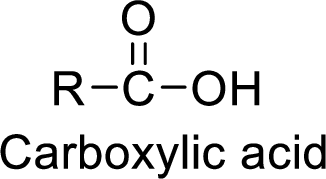
CHEMISTRY >CUSTOM<
8th Edition
ISBN: 9781309097182
Author: SILBERBERG
Publisher: MCG/CREATE
expand_more
expand_more
format_list_bulleted
Concept explainers
Question
Chapter 15, Problem 15.64P
Interpretation Introduction
Interpretation:
The carboxylic acids that are possible for the molecular formula
Concept Introduction:
Carboxylic acids consist of a carbon atom bonded to two oxygen atoms. One oxygen atom is bonded by a double bond and the other oxygen is bonded to the carbon as hydroxide ion (

Expert Solution & Answer
Want to see the full answer?
Check out a sample textbook solution
Chapter 15 Solutions
CHEMISTRY >CUSTOM<
Ch. 15.2 - Prob. 15.1AFPCh. 15.2 - Prob. 15.1BFPCh. 15.2 - Prob. 15.2AFPCh. 15.2 - Prob. 15.2BFPCh. 15.2 - How many peaks appear in the NMR spectrum of each...Ch. 15.2 - Prob. B15.2PCh. 15.2 - Prob. B15.3PCh. 15.3 - Prob. 15.3AFPCh. 15.3 - Prob. 15.3BFPCh. 15.4 - Prob. 15.4AFP
Ch. 15.4 - Prob. 15.4BFPCh. 15.4 - Prob. 15.5AFPCh. 15.4 - Prob. 15.5BFPCh. 15.4 - Prob. 15.6AFPCh. 15.4 - Prob. 15.6BFPCh. 15.4 - Prob. 15.7AFPCh. 15.4 - Prob. 15.7BFPCh. 15.6 - Prob. B15.4PCh. 15.6 - Prob. B15.5PCh. 15 - Prob. 15.1PCh. 15 - Prob. 15.2PCh. 15 - Prob. 15.3PCh. 15 - Silicon lies just below carbon in Group 4A(14) and...Ch. 15 - What is the range of oxidation states for carbon?...Ch. 15 - Prob. 15.6PCh. 15 - Prob. 15.7PCh. 15 - Define each type of isomer: (a) constitutional;...Ch. 15 - Prob. 15.9PCh. 15 - Prob. 15.10PCh. 15 - Prob. 15.11PCh. 15 - How does an aromatic hydrocarbon differ from a...Ch. 15 - Prob. 15.13PCh. 15 - Prob. 15.14PCh. 15 - Prob. 15.15PCh. 15 - Prob. 15.16PCh. 15 - Prob. 15.17PCh. 15 - Prob. 15.18PCh. 15 - Prob. 15.19PCh. 15 - Prob. 15.20PCh. 15 - Prob. 15.21PCh. 15 - Prob. 15.22PCh. 15 - Prob. 15.23PCh. 15 - Prob. 15.24PCh. 15 - Draw structures from the following names, and...Ch. 15 - Prob. 15.26PCh. 15 - Prob. 15.27PCh. 15 - Prob. 15.28PCh. 15 - Prob. 15.29PCh. 15 - Prob. 15.30PCh. 15 - Prob. 15.31PCh. 15 - Prob. 15.32PCh. 15 - Prob. 15.33PCh. 15 - Prob. 15.34PCh. 15 - Prob. 15.35PCh. 15 - Prob. 15.36PCh. 15 - Prob. 15.37PCh. 15 - Prob. 15.38PCh. 15 - Prob. 15.39PCh. 15 - Prob. 15.40PCh. 15 - Determine the type of each of the following...Ch. 15 - Prob. 15.42PCh. 15 - Prob. 15.43PCh. 15 - Prob. 15.44PCh. 15 - Prob. 15.45PCh. 15 - Prob. 15.46PCh. 15 - Prob. 15.47PCh. 15 - Prob. 15.48PCh. 15 - Prob. 15.49PCh. 15 - Prob. 15.50PCh. 15 - Prob. 15.51PCh. 15 - Prob. 15.52PCh. 15 - Prob. 15.53PCh. 15 - Prob. 15.54PCh. 15 - Prob. 15.55PCh. 15 - Prob. 15.56PCh. 15 - Prob. 15.57PCh. 15 - Prob. 15.58PCh. 15 - Prob. 15.59PCh. 15 - Prob. 15.60PCh. 15 - Prob. 15.61PCh. 15 - Prob. 15.62PCh. 15 - Prob. 15.63PCh. 15 - Prob. 15.64PCh. 15 - Prob. 15.65PCh. 15 - Prob. 15.66PCh. 15 - Prob. 15.67PCh. 15 - Prob. 15.68PCh. 15 - Prob. 15.69PCh. 15 - Prob. 15.70PCh. 15 - Prob. 15.71PCh. 15 - Prob. 15.72PCh. 15 - Prob. 15.73PCh. 15 - Prob. 15.74PCh. 15 - Prob. 15.75PCh. 15 - Prob. 15.76PCh. 15 - Prob. 15.77PCh. 15 - Prob. 15.78PCh. 15 - Prob. 15.79PCh. 15 - Prob. 15.80PCh. 15 - Prob. 15.81PCh. 15 - Prob. 15.82PCh. 15 - Prob. 15.83PCh. 15 - Prob. 15.84PCh. 15 - Prob. 15.85PCh. 15 - Prob. 15.86PCh. 15 - Prob. 15.87PCh. 15 - What is the key structural difference between...Ch. 15 - Protein shape, function, and amino acid sequence...Ch. 15 - What linkage joins the monomers in each strand of...Ch. 15 - What is base pairing? How does it pertain to DNA...Ch. 15 - RNA base sequence, protein amino acid sequence,...Ch. 15 - Prob. 15.93PCh. 15 - Prob. 15.94PCh. 15 - Draw the structure of each of the following...Ch. 15 - Prob. 15.96PCh. 15 - Write the sequence of the complementary DNA strand...Ch. 15 - Prob. 15.98PCh. 15 - Prob. 15.99PCh. 15 - Prob. 15.100PCh. 15 - Prob. 15.101PCh. 15 - Amino acids have an average molar mass of 100...Ch. 15 - Prob. 15.103PCh. 15 - Prob. 15.104PCh. 15 - Some of the most useful compounds for organic...Ch. 15 - Prob. 15.106PCh. 15 - Prob. 15.107PCh. 15 - Prob. 15.108PCh. 15 - Prob. 15.109PCh. 15 - Prob. 15.110PCh. 15 - Prob. 15.111PCh. 15 - Prob. 15.112PCh. 15 - The polypeptide chain in proteins does not exhibit...Ch. 15 - Prob. 15.114PCh. 15 - Prob. 15.115PCh. 15 - Prob. 15.116PCh. 15 - Prob. 15.117PCh. 15 - Wastewater from a cheese factory has the following...Ch. 15 - Prob. 15.119P
Knowledge Booster
Learn more about
Need a deep-dive on the concept behind this application? Look no further. Learn more about this topic, chemistry and related others by exploring similar questions and additional content below.Recommended textbooks for you
 ChemistryChemistryISBN:9781305957404Author:Steven S. Zumdahl, Susan A. Zumdahl, Donald J. DeCostePublisher:Cengage Learning
ChemistryChemistryISBN:9781305957404Author:Steven S. Zumdahl, Susan A. Zumdahl, Donald J. DeCostePublisher:Cengage Learning ChemistryChemistryISBN:9781259911156Author:Raymond Chang Dr., Jason Overby ProfessorPublisher:McGraw-Hill Education
ChemistryChemistryISBN:9781259911156Author:Raymond Chang Dr., Jason Overby ProfessorPublisher:McGraw-Hill Education Principles of Instrumental AnalysisChemistryISBN:9781305577213Author:Douglas A. Skoog, F. James Holler, Stanley R. CrouchPublisher:Cengage Learning
Principles of Instrumental AnalysisChemistryISBN:9781305577213Author:Douglas A. Skoog, F. James Holler, Stanley R. CrouchPublisher:Cengage Learning Organic ChemistryChemistryISBN:9780078021558Author:Janice Gorzynski Smith Dr.Publisher:McGraw-Hill Education
Organic ChemistryChemistryISBN:9780078021558Author:Janice Gorzynski Smith Dr.Publisher:McGraw-Hill Education Chemistry: Principles and ReactionsChemistryISBN:9781305079373Author:William L. Masterton, Cecile N. HurleyPublisher:Cengage Learning
Chemistry: Principles and ReactionsChemistryISBN:9781305079373Author:William L. Masterton, Cecile N. HurleyPublisher:Cengage Learning Elementary Principles of Chemical Processes, Bind...ChemistryISBN:9781118431221Author:Richard M. Felder, Ronald W. Rousseau, Lisa G. BullardPublisher:WILEY
Elementary Principles of Chemical Processes, Bind...ChemistryISBN:9781118431221Author:Richard M. Felder, Ronald W. Rousseau, Lisa G. BullardPublisher:WILEY

Chemistry
Chemistry
ISBN:9781305957404
Author:Steven S. Zumdahl, Susan A. Zumdahl, Donald J. DeCoste
Publisher:Cengage Learning

Chemistry
Chemistry
ISBN:9781259911156
Author:Raymond Chang Dr., Jason Overby Professor
Publisher:McGraw-Hill Education

Principles of Instrumental Analysis
Chemistry
ISBN:9781305577213
Author:Douglas A. Skoog, F. James Holler, Stanley R. Crouch
Publisher:Cengage Learning

Organic Chemistry
Chemistry
ISBN:9780078021558
Author:Janice Gorzynski Smith Dr.
Publisher:McGraw-Hill Education

Chemistry: Principles and Reactions
Chemistry
ISBN:9781305079373
Author:William L. Masterton, Cecile N. Hurley
Publisher:Cengage Learning

Elementary Principles of Chemical Processes, Bind...
Chemistry
ISBN:9781118431221
Author:Richard M. Felder, Ronald W. Rousseau, Lisa G. Bullard
Publisher:WILEY